Keep reading to get the details on my CVA Wolf Northwest review.
I recently purchased a new muzzleloader in preparation for upcoming muzzleloader hunting season. I’ve tested it out extensively at the range and afield today’s article is a review of my CVA Wolf Northwest legal muzzleloader. It is a variation of their Wolf line of muzzleloaders that CVA designed in order to provide the reliability and convenience of an in-line muzzleloader, yet still meet the legal requirements for use in Washington, Oregon, and Idaho.
I purchased my CVA Wolf Northwest from Muzzle-Loaders.com, a company based out of Oregon that sells muzzleloaders and their accessories. I paid the full retail price for the muzzleloader and had no relationship with the company at the time.
However, because they sell quality products at a reasonable price, take great care of their customers, and since they are an American small business run by people with values closely aligned with mine, I now have an affiliate partnership with the company. All the links on this site to Muzzle-Loaders.com (as well as the links to Amazon) are affiliate links. This means I will earn a small commission if you make a purchase.
This commission comes at no extra cost to you. This helps support the blog and allows me to continue to create free content that’s useful to hunters like yourself. Thanks for your support.
Now that we’ve got that out of the way, let’s get started.
The Wolf is CVA’s entry level break action muzzleloader, below the Accura and Optima (read my CVA Optima Northwest review to see how they stack up against each other). Just because it is an entry level muzzleloader doesn’t mean it is a piece of junk though. On the contrary, I think it’s one of the best muzzleloaders currently manufactured and I’m pretty impressed with the performance of such a reasonably priced muzzleloader.
The base model Wolf has a .50 caliber, 24” stainless steel barrel, a reversible hammer spur to accommodate left or right handed shooters, an ambidextrous breech, a very nice recoil pad, DuraBright fiber optic open sights, a quick release breech plug, and is drilled and tapped for a scope.The CVA Wolf Northwest goes a step further by modifying the breech plug to be compliant with the hunting regulations in Washington, Oregon, and Idaho.
In order to accomplish this, the breech plug is designed to work with loose (instead of pelletized) powder, fit a musket cap (instead of a 209 primer), and has four holes cut into the sides of it that ensures that the ignition system is “exposed to the elements” in accordance with the regulations for muzzleloader season. By making these few adjustments to the Wolf, CVA was able to design a muzzleloader that incorporates nearly all of the benefits of an in-line muzzleloader, while still being legal to use in the Pacific Northwest.
Update Fall 2018
The Washington Department of Fish and Wildlife updated the muzzleloader hunting regulations for the state in 2018. The new regulations now permit the use of 209 primers and no longer require the cap to be exposed to the weather. All other muzzleloader requirements for Washington remain the same.
Hunters with a CVA Wolf Northwest can purchase a 209 primer conversion kit (which consists of a new breech plug and firing pin set) to utilize 209 primers with their muzzleloader. Likewise, the standard CVA Wolf muzzleloader with iron sights is now legal to use in Washington as well.
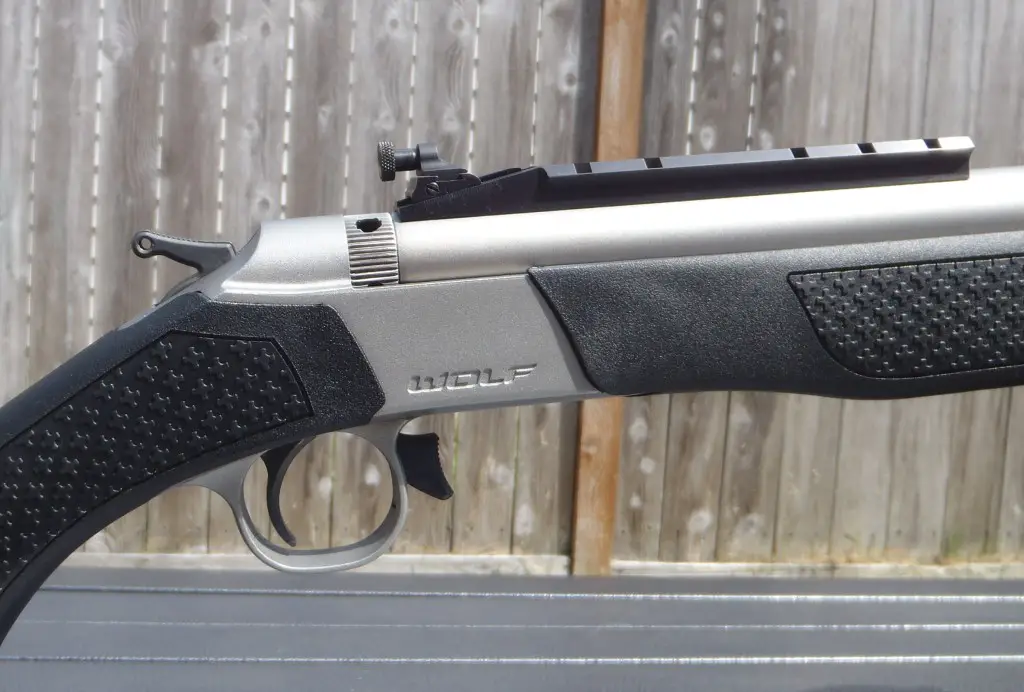
At this time, Idaho and Oregon still prohibit the use of 209 primers on muzzleloaders, so the CVA Wolf Northwest remains a great option for hunting in those states.
When I received my CVA Wolf Northwest, I was immediately impressed by the obvious quality in the workmanship exhibited in the muzzleloader. The Wolf fit me nicely and was lightweight, quick to mount, and pointed very well. The breech opened easily and smoothly by simply depressing the lever on the trigger guard. The trigger, while it will never be compared to the trigger on a competition 1911, was still pretty smooth, and broke cleanly with 3 pounds of pressure, and had very little overtravel.
The CVA Wolf Northwest has a 1:28” rifling twist, making it suitable for most full size (non-saboted) projectiles. CVA recommends using PowerBelt bullets. This is not surprising, considering they are made by the same company. However, conicals and sabots made by Thompson Center, Hornady, Barnes, and other companies will also work. Though I haven’t spent a great deal of time trying to develop highly accurate round ball loads, my CVA Wolf Northwest also did reasonably well when shooting plain old round balls. However, CVA does recommend only using projectiles weighting less than 400 grains in the Wolf Northwest for best results.
As with most muzzleloaders, the CVA Wolf Northwest is designed to use up to 150 grains of black powder or a black powder substitute, such as Hodgon’s 777 or Pyrodex. Under no circumstances should smokeless powder be used in the Wolf Northwest (or any muzzleloader for that matter). However, even though the muzzleloader will safely handle up to 150 grains of black powder, that does not mean that using a maximum load of propellant will produce the best results. CVA recommends using 80-120 grains of black powder for best accuracy, though results will vary between different muzzleloaders.
For more detailed information on getting your CVA Wolf to shoot accurately, check out these other articles:
15 Of The Best Muzzleloader Primers For Igniting Your Powder
Blackhorn 209 vs 777 vs Goex Black Powder: Which One Should You Use In Your Muzzleloader?
9 Best Muzzleloader Scopes For Hunters
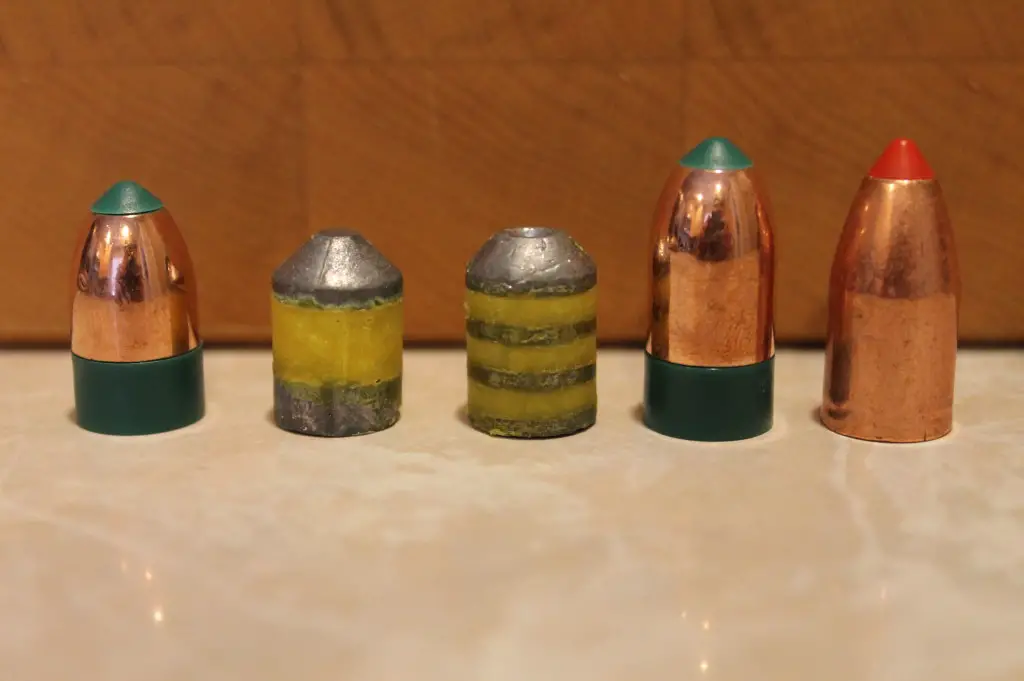
Over the past few months, I’ve shot my Wolf Northwest using several different loads of Goex FFg black powder and Hodgon’s 777 with 350gr Hornady FPB bullets, 245gr and 348gr PowerBelt AeroTips, 320gr Thompson Center Maxi-Balls, and 350gr Thompson Center Maxi-Hunters. Additionally, I’ve also shot 250gr Hornady SSTs, 250gr Barnes TMZs, and 250gr Barnes T-EZs in the Wolf Northwest and you can read about the details here. All powder measures were by volume. To compare each load, I measured the velocity using my chronograph and measured the group size at 100 yards.
The results are in the table below.As you can see, the Wolf Northwest really liked the PowerBelts, and to a lesser extent, the Hornady FPBs. Though I think I’ve wrung all of the performance I’m realistically going to get out of the 245gr PowerBelts, I think there is still some room for improvement with the 348gr PowerBelts and the Hornady FPBs. I’m going to continue to experiment and tweak my loads with those bullets and see what kind of results I get.
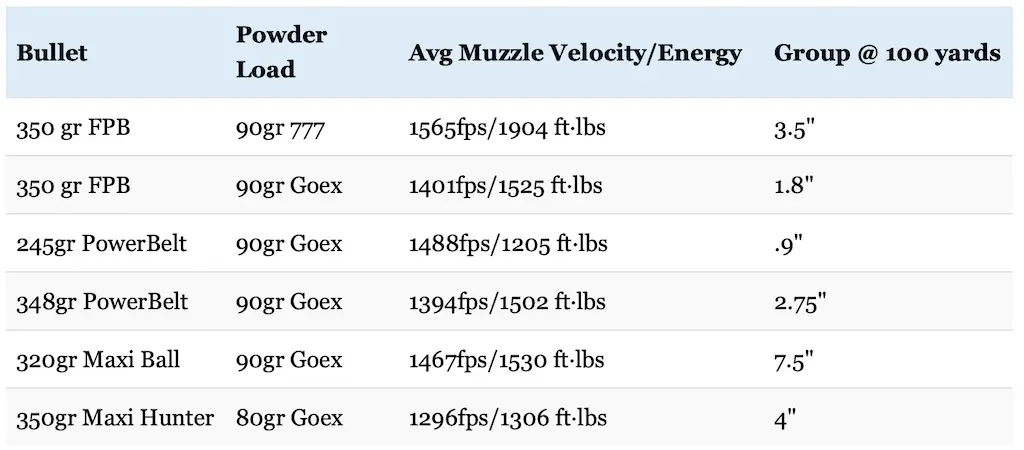
The Hornady FPBs were the most difficult to load of all the bullets I tested. I’ve read horror stories of shooters having to use a ridiculous amount of force, sometimes even to the point of having to use a hammer to properly seat the FPBs. I’m pleased to say that this was not my experience. Though they needed the most force to load and required the use of a bullet starter, they were not excessively difficult to ram home. The PowerBelts were not difficult at all to load. However, they left a significant amount of residue in the barrel after each shot, while the FPBs did not.
On the other end of the spectrum, the Thompson/Center bullets did not perform well at all, and I’m pretty disappointed with the results I obtained with them. The bullets were very easy to load, almost too easy. I suspect that they were not fully engaging the rifling and generating a good seal when fired. This likely accounts for the reduced velocity and accuracy I observed with them. As a result, I’m not going to continue to experiment with either of these bullets.
Overall, I was impressed with the performance of the PowerBelts and the FPBs. With the accuracy I was achieving with the 245gr PowerBelts, I’m comfortable with taking a shot out to around 150 yards on a deer. However, I’m a little concerned about using PowerBelts on elk. I think that the FPBs will perform better, and I feel comfortable taking a 100 yard shot on an elk with the accuracy I’m obtaining with them at this point.
Unfortunately, my Wolf Northwest does not seem to like Hodgon’s 777. Though it consistently produced significantly higher velocities than the Goex black powder, I had numerous ignition problems with it. Specifically, it would have a very fast (~ 1/4 to 1/2 second) hang fire on nearly every shot. This made for a small, but noticeable delay between the fall of the hammer and the gun firing that adversely affected my accuracy. I’m not sure if I just have a bad batch of powder, or if this is typical performance of Hodgon’s 777 when used with a musket cap. I can say with certainty that I have never had a single ignition problem with my Goex black powder in the Wolf Northwest, or any other muzzleloader I’ve ever shot.
Another great aspect of the CVA Wolf Northwest is how easy the muzzleloader is to clean. The “quick release” breech plug also lived up to its name. Even after shooting it all day at the range, I never had any issues removing the breech plug using just my fingers. In between shots, and after finishing for the day at the range, cleaning the muzzleloader was a simple matter of removing the breech plug and running a few patches through the bore.
Note: I do recommend putting some lubricant (available here) on the threads of the breech plug after cleaning to ensure that it’s always easy to remove after a day of shooting.
Also, by simply changing the breech plug and the firing pin system, the CVA Wolf Northwest may be converted to use 209 primers. Since it is also drilled and tapped for a scope, it is a great choice for a hunter who hunts in multiple states with varying laws for hunting with muzzleloaders. For instance, I used this muzzleloader in the northwest configuration to hunt blacktail deer in Washington last year. However, I was also able to mount a scope on it and switch over to 209 primers to use it on a Quinault Indian Reservation bear hunting trip.
Unfortunately, the CVA Wolf Northwest is not a perfect muzzleloader and it does have a few problems. There are two areas where I was not impressed with its performance: the quality of the factory installed sights and the initial reliability of the ignition system. Fortunately, I was able to easily correct both of these problems.
The open sights that came with the CVA Wolf Northwest were of marginal quality. The fact that both the front and rear sights were fiber optic greatly enhanced their utility in low light conditions. However, the sights appeared cheaply made and were difficult to adjust precisely. In general, I do not like open sights, as they are the least accurate of all iron sights. Additionally, the rear sight was mounted near the middle of the barrel. This cut down on the sight radius and made it even less precise.
Luckily, the E. Arthur Brown Company makes a reasonably priced peep sight/scope mount combination designed specifically to mount on CVA muzzleloaders (Williams makes another good one). No special tools were needed for installation and it only took me a couple of minutes to install it on my muzzleloader. The peep sight was a tremendous step up in quality and my shooting improved dramatically once I mounted it.
This sight mounts just in front of the breech plug, which increased the sight radius from 14” to 22 ½”. Additionally, this sight has the added benefit of allowing for the use of a scope (when legal) while still having the peep sight mounted.A slightly more frustrating problem I encountered when first shooting the CVA Wolf Northwest was unreliable ignition of the musket caps.
The manual stated that the rifle was designed for use with RWS Musket Caps and recommended their use. However, even when using the exact musket caps that CVA recommended, two or three caps out of ten would fail to function. Upon inspection of the caps, it was clear that the firing pin was striking them and leaving a noticeable dimple. The musket cap would always function properly when I tried a second time though, leading me to believe that the spring on my muzzleloader was weak and not allowing the firing pin to strike with enough force.
Fortunately, CVA was very helpful and easy to work with when I called and reported the problem. They replaced my hammer spring for free and gave me a 30% off coupon to their online store for the inconvenience. After replacing the spring, the muzzleloader functioned perfectly and I have not had a single ignition problem since. Hopefully, this is not an issue many other people will have to deal with.
All in all, I’m pleased with the performance of the CVA Wolf Northwest. I would recommend this muzzleloader for hunters in the Pacific Northwest who are interested in taking advantage of the opportunities present during muzzleloader season, but who also would like some of the conveniences associated with an in-line muzzleloader.
With a price of less than $250 (currently on sale for $249 as of 28 October 2022), the CVA Wolf Northwest is an especially good bargain for a hunter looking for a first muzzleloader.

Update 6 December 2014
I shot my first blacktail (and my first deer with a muzzleloader) a couple days ago using the CVA Wolf Northwest. It was a grueling hunt under cold and wet conditions, but the CVA Wolf Northwest performed well. It fired when I pulled the trigger and put the bullet (a 290gr Barnes T-EZ) right where I was aiming. The deer ran less than 30 yards after the shot.
During the course of the 2014 Washington deer season, my CVA Wolf Northwest did everything that I asked of it. Not only is it lightweight and easy to carry, but it worked without fail. I hunted in some nasty condition conditions: pouring down rain, snow, and bitter cold temperatures. Even under the worst of conditions, the CVA Wolf Northwest always treated me well: every time I pulled the trigger the gun fired and it always hit where I was aiming.
What else do you need from a hunting rifle?
Update 12 May 2015
The CVA Wolf Northwest just struck again on a Quinault Indian Reservation bear hunting trip. I mounted a scope on my CVA Wolf Northwest and used a conversion kit made by CVA to switch it over to 209 primers for this hunt (both of which are legal on muzzleloaders in Washington if you’re not hunting deer or elk). I used a 290gr Barnes T-EZ propelled by 100gr of loose Hodgdon’s 777 powder. I hit the bear (a ~150 pound sow) right behind the shoulder and she ran 30-40 yards after the shot.
Rating
Affordability: 5/5
Availability: 4/5
Performance: 3/5
Reliability & Durability: 4/5
Size & Weight: 5/5
Overall: 4.2/5
If you like what you’ve read so far and are looking for a great Northwest Legal muzzleloader for a reasonable price, then I highly recommend purchasing a CVA Wolf Northwest muzzleloader.
Enjoy this CVA Wolf Northwest Review? Please share it with your friends on Facebook and Twitter.
Make sure you subscribe to The Big Game Hunting Podcast and follow The Big Game Hunting Blog on Facebook, Instagram, Twitter, and YouTube.
NEXT: 13 OF THE BEST MUZZLELOADER BULLETS FOR HUNTERS
NEXT: BEST GIFTS FOR HUNTERS
NEXT: BEST HUNTING EAR PROTECTION FOR SPORTSMEN IN 2021
John McAdams is a proficient blogger, experienced shooter, and long time hunter who has pursued big game in 8 different countries on 3 separate continents. John graduated from the United States Military Academy at West Point and is a veteran of combat tours with the US Army in Iraq & Afghanistan. In addition to founding and writing for The Big Game Hunting Blog, John has written for outdoor publications like Bear Hunting Magazine, The Texas State Rifle Association newsletter, Texas Wildlife Magazine, & Wide Open Spaces. Learn more about John here, read some of John’s most popular articles, and be sure to subscribe to his show: the Big Game Hunting Podcast.

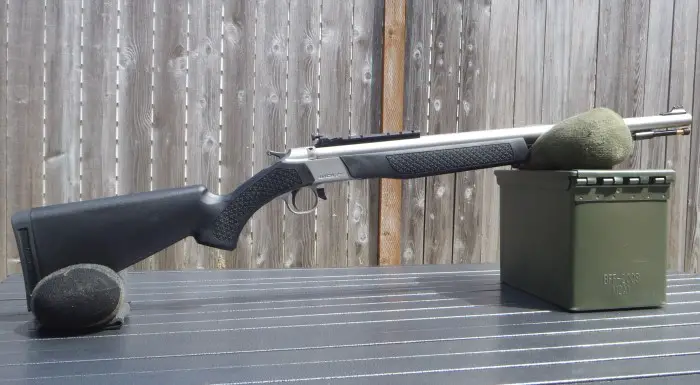
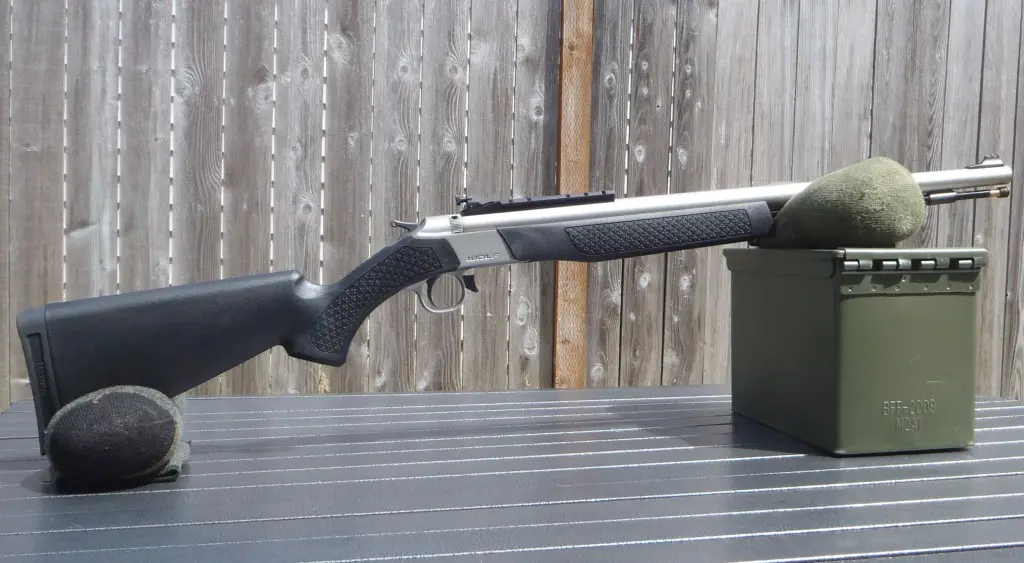
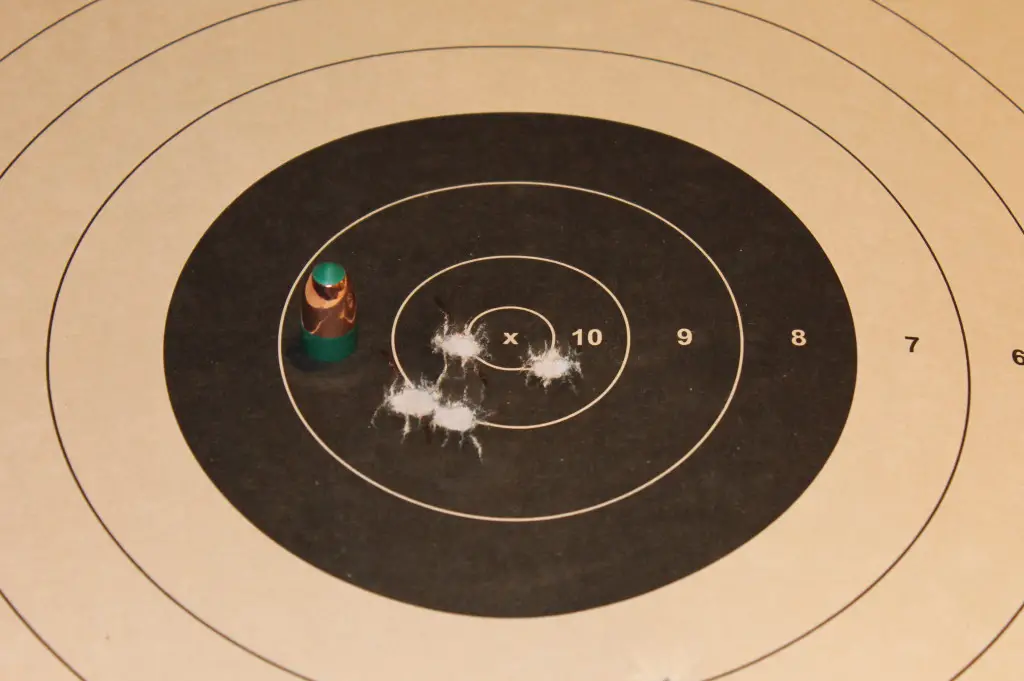
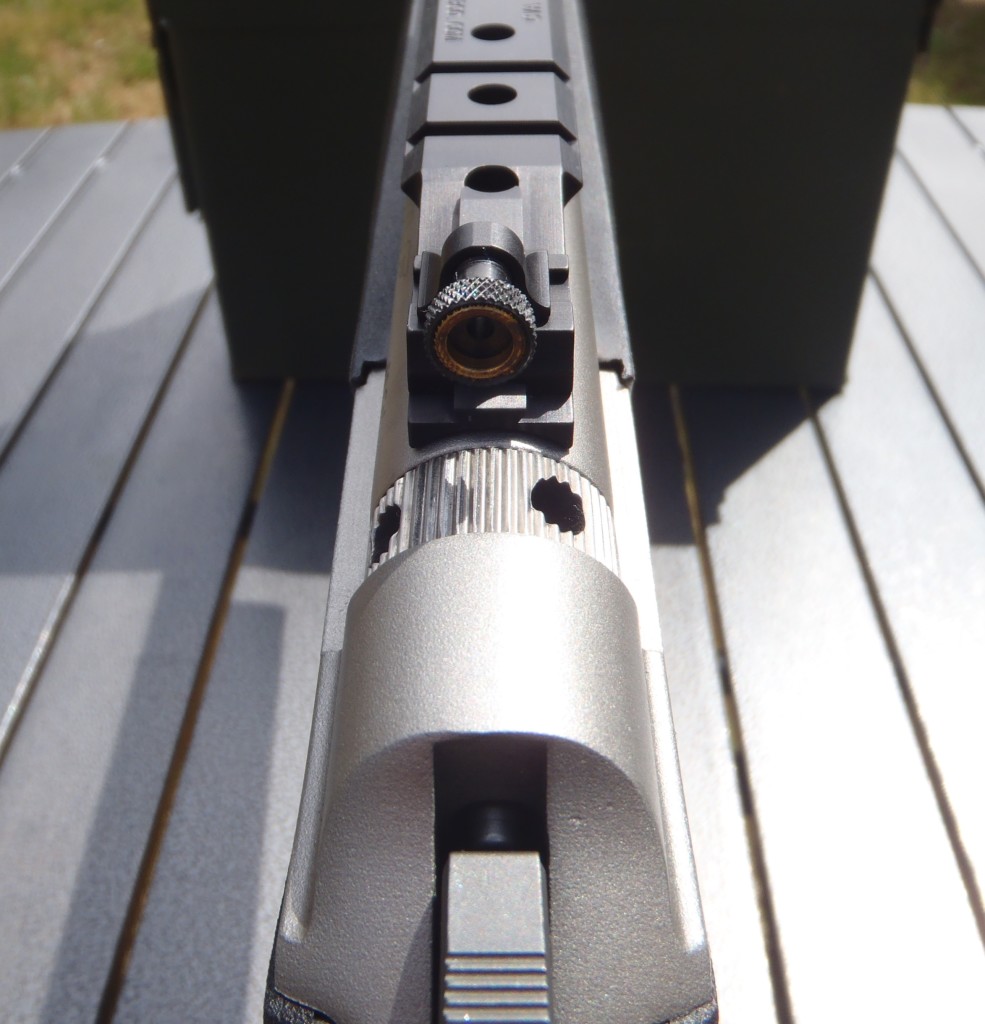
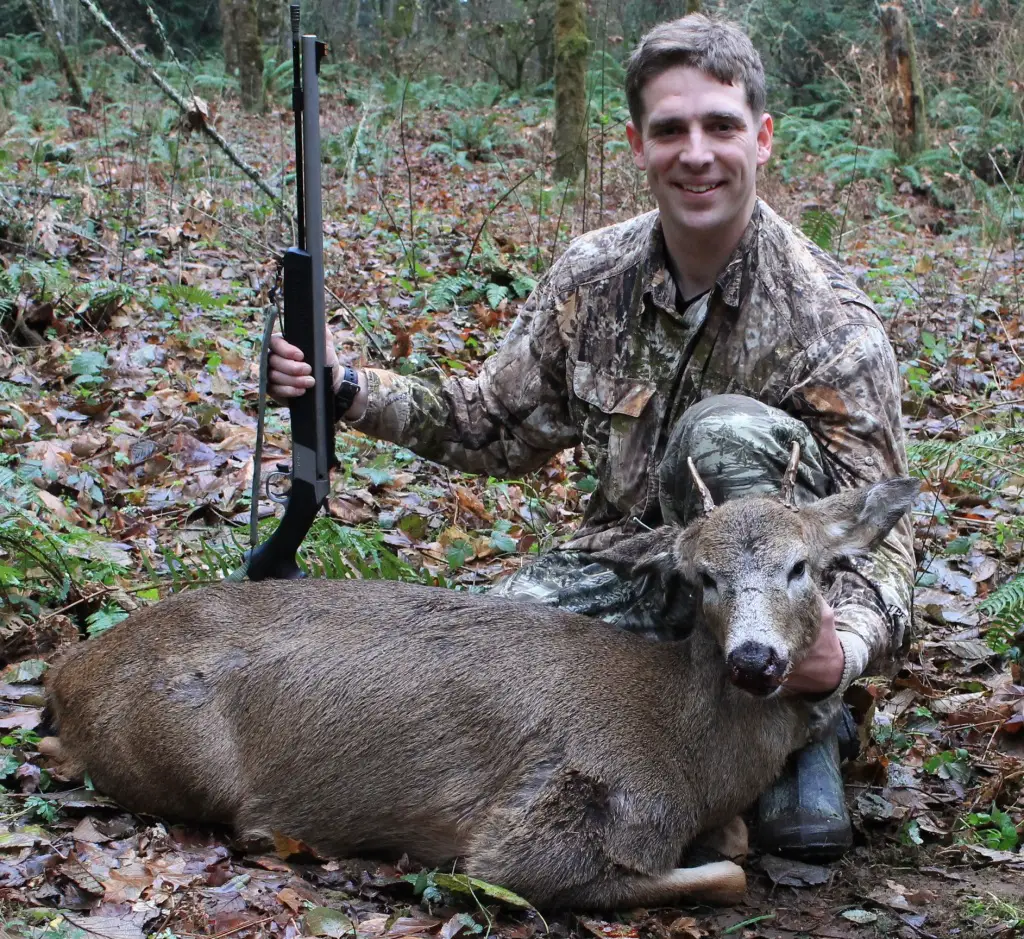
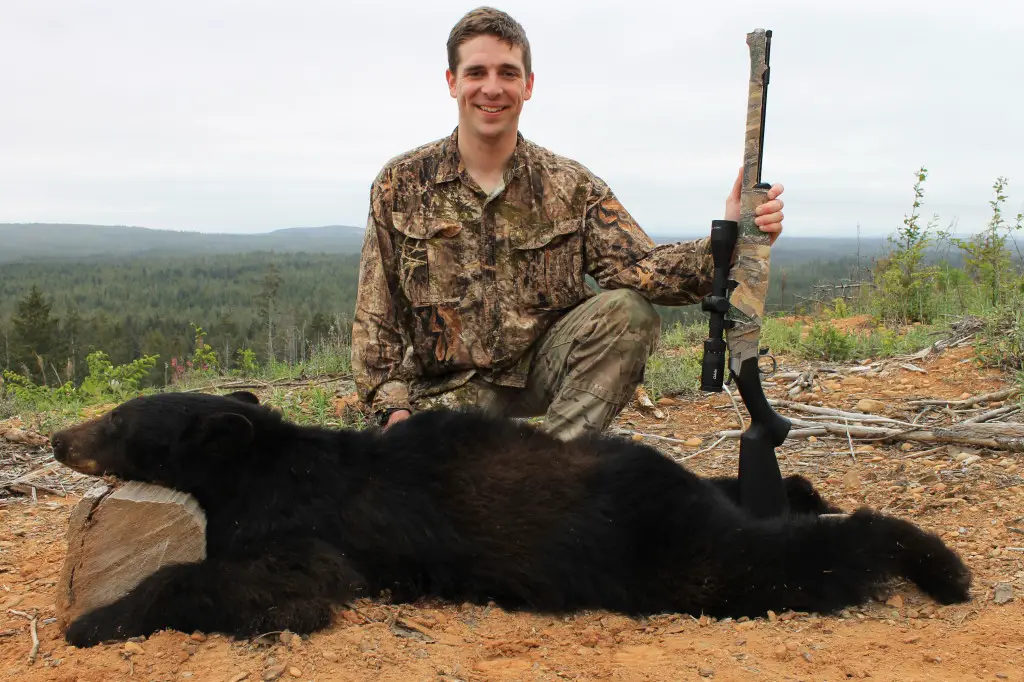
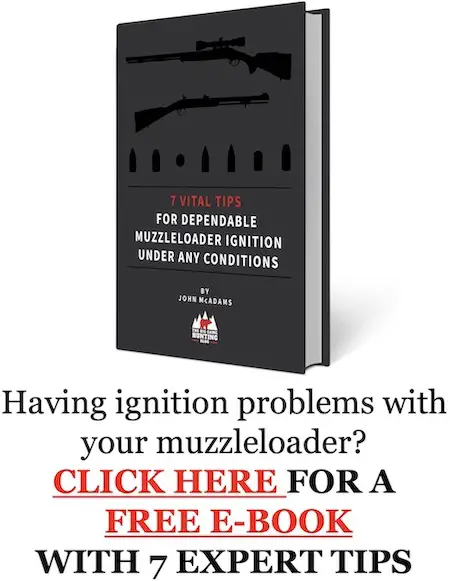
Hey there what’s the story with the breech plug ,I use the primers in my wolf , but whenever I want to clean the gun barrel ,always a problem removing plug like putting it in a vise and lots of cursing , is the some kind of anti seize paste or something i can use to prevent the cursing .
Thanks Darren
As a matter of fact there is. Below are links to the anti-seize stick I use.
https://amzn.to/2VkewpV
or
https://www.muzzle-loaders.com//cva-anti-seize-stick-ac1682.html?utm_source=BGHB&utm_medium=referral&utm_campaign=cva_anti-seize
I have had my NW wolf for a few years. First problem was inconsistent ignition. Thought was a spring issue. Installed new spring and still same problem, 2 or 3 times out of 10 it would fire first time. Contacted CVA again and they sent me a new breech plug as my wolf had a recall or notice issued for bad breech plug. Received the new plug and fired 100% every time. Compared the two plugs and it was evident the tiny land the firing pin hit was huge on my old plug. I machined the old plug to a similiar dimension as the new and now I have 2 reliable plugs!! Yea!
I shoot 295 gr powerbelt lead ( as I live in Idaho) with 90 gr of Black MZ by Alliant. Shoots better than Goex, Non-corrosive, semi waterproof and higher muzzle velocity. Too bad they quit making it so I stocked up when Sportsman Whse had it for $9,95 pound!!! The barrel residue is a white powder and easily cleaned with no fouling even after 15-20 shots.. Very impressive powder.